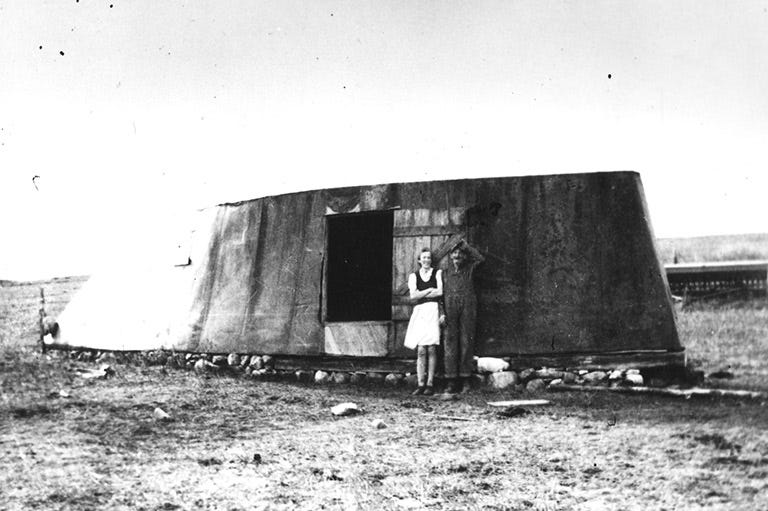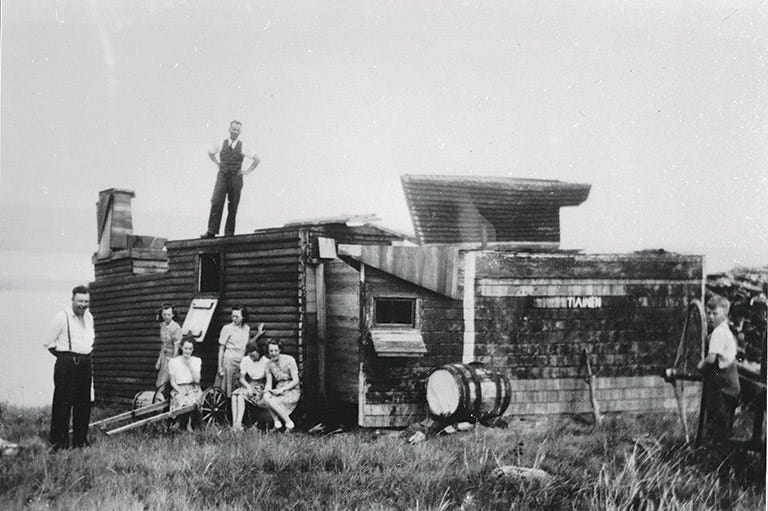Tom Sukanen came to North America to find a new home. He was a man who lost his family in the process and wanted only to go back to Finland.
To get back home, he built a ship on his Saskatchewan farm.
Locals called him The Crazy Finn, but he was just a man with a dream.
Born in Finland in 1870, Tom Sukanen began working as a sailor. At just under six feet, with a barrel chest, broad shoulders and immense strength, he was able to find plenty of work on ships.
In 1906, he married Sanna Rintala and then sailed to the United States, leaving his pregnant wife in Finland. It was believed he did this to avoid being drafted into the Russian army. One year later, his wife joined him, settling in Minnesota.
Tom was able to get work in the iron ore mines, owing to his strength and strong work ethic. Tom was believed to have tried to unionize the mine, possibly to help support his family that now numbered a boy and three girls. One night, their house burned down. While the family escaped, one daughter had scars for the rest of her life. Many speculate that this was arson due to the union activities of Tom.
Sadly, this was only the tip of the issues to hit Tom that year. In the local newspaper on March 31, 1911, it was reported that his wife was sent by court order to Duluth to assess her mental condition.
Soon after, he received word that his brother had begun homesteading in Saskatchewan. He made the decision to go there, leaving his wife and family behind.
He began to homestead in southern Saskatchewan near Moose Jaw, farming for seven years, working to establish a home for his family.
Upon his return to Minnesota, he discovered that his wife had died in an asylum, his children were in foster homes and his Minnesota farm was abandoned.
He attempted to bring his son back to Saskatchewan but the son was turned back at the Canada-US border.
Arriving back at his farm, he built a rowboat and headed for the Hudson Bay, where he found work on a freighter that took him to Finland, and then back.
Upon his return, he began to build a sea vessel to allow for his permanent repatriation to his homeland of Finland and the legend of the Crazy Finn, as locals called him, began.
At the time, Tom lived 26 kilometres from the South Saskatchewan River.
Tom’s plan was to take his ship to the South Saskatchewan in two parts. The parts would be put on a raft and his old car engine would be outfitted with a propeller to propel him up the river. Once he reached Hudson Bay, he would bolt the keel, hull and cabins together, stuff the keel with rocks for ballast and right the ship in salty water.
Locals saw pieces of his farm disappear as the boat took shape. His barn, granaries and eventually his house were taken apart for lumber to use in the ship. Eventually, he lived in the hull of the ship, installing a coalwood stove for cooking and heating.
Building his boat, he had only rudimentary tools, some sawed-off sledgehammers, an anvil, a hand drill, forge, a wood saw and a hacksaw. With these items, he put a ship together that measured 13.1 metres long, three metres high, with a 2.7 metre beam. The keel was 9.1 metres long at the water line and 2.7 metres deep.
Through sheer brute force, Tom made the steam cylinders, pistons and boilers for the ship. Upon seeing the engine years later, a CPR engineer said that it was normally accomplished using a huge press, not the strength of one’s arms with a hammer.
When the ship was nearly done, Tom built two small cabins that were mounted on the deck, fore and aft. One was his sleeping quarters, one was the wheelhouse.
Finally, the ship was finished and Tom named it the Sontianen, Finnish for Little Dung Beetle. He then asked a neighbour to help him move the pieces of the ship with his tractor. Perhaps out of fear for being seen helping the Crazy Finn, the neighbour refused.
Tom took matters into his own hands. Using a set of iron wheels under the end of one hull and a dozen fence posts, and only one horse, he only made a few metres of progress per day. Eventually, he was dragging the ship himself using a winch tied to a post in the ground.
By this point, he was close to starving, his strength was gone and he was sullen and miserable. Through all of it, he never asked for help and insisted on moving the ship himself.
By 1939, after complaints, the RCMP stepped in and went out to find Tom. By this point, Tom had moved the ship 4.8 kilometres. When he was found, he was so weak he had to be helped to his feet. The RCMP officer, Constable Bert Fisk, put him in the front seat of his car and drove him to the mental hospital in North Battleford.
While Tom was gone, his ship was looted and vandalized, his tools stolen and his gear thrown around the prairie. Those who visited Tom made sure not to tell him this. One day, a visitor accidently let it slip and Tom knew his dream had come to an end.
On April 23, 1943, he died in the North Battleford Asylum, as his wife had so many years previous.
Years later, Laurence Mullin arranged for the restoration of the ship and in it was moved in 1977 on the back of a truck to what is now the Sukanen Ship and Pioneer Museum near Moose Jaw. Tom’s body was also moved from North Battleford, to rest by the boat that he spent the last years of his life building.







